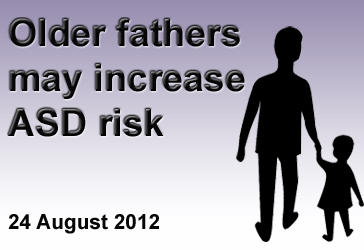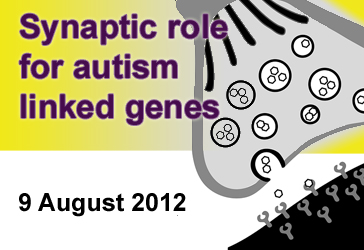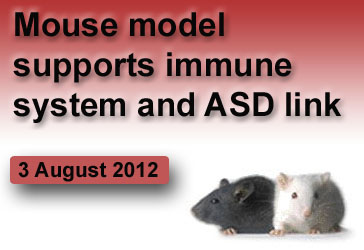Archives
August, 2012
Select a different month in the archive
Older Fathers May Increase Risk of Autism
By Catherine Croft Swanwick, Ph.D. on August 24, 2012

Background: Previous epidemiological studies have reported an association between older parents and increased risk of Autism Spectrum Disorders (ASD).
What’s New: A recent study quantified the risk of ASD as parents age. Scientists studied genetic material from families whose children developed ASD or schizophrenia despite no family history of these disorders, allowing them to search for mutations which occur spontaneously, or de novo, in embryos after they are inherited.
The research team found that DNA inherited from fathers undergoes more mutation as their age at the time of conception increases. They estimate that DNA inherited from a 20-year-old father undergoes approximately 25 de novo mutations, and that this number increases by two for every additional year of the father’s age. Unlike other studies, they found no correlation between maternal age and ASD.
Why It’s Important: Hundreds of de novo mutations have been linked with ASD. This study shows how quickly the rate of de novo mutations increases as fathers age. The average age of fathers at time of conception is steadily increasing worldwide, suggesting that advanced paternal age may play a role in the rising prevalence of ASD.
Help me understand :
| Source(s) : |
| Tweet |
Discovery May Shed Light on Autism Brain Activity
By Catherine Croft Swanwick, Ph.D. on August 17, 2012
Overview: Scientists recently discovered the mathematical formula underlying two types of inhibitory brain circuits.
Background: One theory of autism predicts that its symptoms are caused by an unbalanced ratio of excitation to inhibition in the brain. Autistic brains may exhibit more excitability, possibly due to increased neuron excitation and/or decreased neuron inhibition.
What’s New: Inhibitory neurons which express parvalbumin divide excitation of their target neurons, whereas those which express somatostatin subtract excitation of their targets.
Why it’s Important: Researchers may now measure the effects of these inhibitory circuits on excitability levels of autistic brains.
Help me understand :
| Source(s) : |
| Tweet |
Autistic Behaviors May Be Connected to Slow Synapses
By Catherine Croft Swanwick, Ph.D. on August 9, 2012

Background: Hundreds of genes are linked to Autism Spectrum Disorders (ASD). Although these genes perform a wide variety of functions, most of them influence synapses. Two well-known ASD risk genes, NRXN1 and NLGN1, are best known as cell adhesion molecules which help form synapses by sticking two neurons together.
What’s New: Emerging evidence indicates new synaptic roles for NRXN1 and NLGN1. In addition to acting as cell adhesion molecules, they send signals which regulate synapse communication. When expression of NRXN1 or NLGN1 was blocked in worms or mice, their synapses communicated slowly and for longer periods of time.
Why it’s Important: This evidence suggests a new neurobiological mechanism which may underlie autistic behaviors. Next steps for scientists include discovering exactly how slower synapse communication may affect cognition.
Help me understand :
| Source(s) : |
| Tweet |
Maternal Infection May Lead to Autism, Immune Dysfunction
By Catherine Croft Swanwick, Ph.D. on August 3, 2012

Background: Maternal infection is a known risk factor for ASD. Various types of maternal infections associate with ASD according to different strengths of evidence: rubella strongly associates with ASD based on numerous scientific publications and animal models, influenza moderately associates with ASD due to conflicting results, and cytomegalovirus weakly associates with ASD with reports from <10 scientific papers.
In order to generate mice displaying ASD symptoms, scientists can mimic maternal infection by activating the immune system of their pregnant mothers. This maternal immune activation (MIA) model is often used to explore neurobiological mechanisms underlying ASD.
What’s New: Scientists used the maternal infection model of ASD (also known as the MIA model) to examine the role of the immune system in ASD. In addition to exhibiting ASD symptoms, mice born to MIA mothers showed problems with their immune systems. Bone marrow transplants from healthy mice both 1) restored their immune system function and 2) reduced ASD symptoms such as repetitive and anxiety-like behaviors.
Why it’s Important: This evidence suggests a link between the immune system and ASD behaviors. Many humans with ASD also possess immune system problems. Future research will most likely focus on the role of the immune system in ASD and whether immunological treatments will help reduce ASD symptoms.
Help me understand :
| Source(s) : |
| Tweet |

